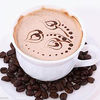iOS系统上可以使用UILable、UITextFileld、TextKit显示文本,TextKit也可以做一些布局控制,但如果需要精细的布局控制,或者自线程异步绘制文本,就必须使用Core Text和Core Graphics,本文比较系统地讲解Core Text排版核心概念。
iOS文本系统框架
iOS文本系统框架
Core Text是iOS 系统文本排版核心框架,TextKit和WebKit都是封装在CoreText上的,TextKit是iOS7引入的,在iOS7之前几乎所有的文本都是 WebKit 来处理的,包括UILable、UITextFileld等,TextKit是从Cocoa文本系统移植到iOS系统的。
文本渲染过程中Core Text只负责排版,具体的绘制操作是通过Core Graphics框架完成的。如果需要精细的排版控制可以使用Core Text,否则可以直接使用Text Kit。
Core Text排版引擎框架
CoreText排版引擎框架
CTFramesetter是Core Text中最上层的类,CTFramesetter持有attributed string并创建CTTypesetter,实际排版由CTTypesetter完成。CTFrame类似于书本中的「页」,CTLine类似「行」,CTRun是一行中具有相同属性的连续字形。CTFrame、CTLine、CTRun都有对应的Draw方法绘制文本,其中CTRun支持最精细的控制。
CoreText排版引擎框架
排版核心概念
要实现精细的排版控制,就必须理解排版的概念,因为Core Text很多api都涉及到排版概念,这些概念是平台无关的,其他系统也一样适应。
排版引擎通过下面两步对文本进行排版:
生成字形(glyph generation)
字形布局(glyph layout)
字符(Characters)和字形(Glyphs)
字符和字形概念比较好理解,下图很直观
Glyphs of the character A
字型(Typefaces)和字体(Fonts)
字型和字体的概念可能没这么好区分,直接引用官方文档的原话
A typeface is a set of visually related shapes for some or all of the characters in a written language.
A font is a series of glyphs depicting the characters in a consistent size, typeface, and typestyle.
字体是字型的子集,字型也叫font family,比如下图:
Fonts in the Times font family
字体属性(Font metrics)
排版引擎要布局字型,就必须知道字型大小和怎样布局,这些信息就叫字体属性,开发过程也是通过这些属性来计算布局的。字体属性由字体设计者提供,同一个字体不同字形的属性相同,主要属性如下图:
Glyph metrics
Glyph metrics
baseline:字符基线,baseline是虚拟的线,baseline让尽可能多的字形在baseline上面,CTFrameGetLineOrigins获取的Origins就是每一行第一个CTRun的Origin
ascent:字形最高点到baseline的推荐距离
descent:字形最低点到baseline的推荐距离
leading:行间距,即前一行的descent与下一行的ascent之间的距离
advance width:Origin到下一个字形Origin的距离
left-side bearing:Origin到字形最左边的距离
right-side bearing:字形最右边到下一个字形Origin的距离
bounding box:包含字形最小矩形
x-height:一般指小写字母x最高的到baseline的推荐距离
Cap-height:一般指H或I最高的到baseline的推荐距离
部分字体属性可以通过UIFont的方法获取,ascent、descent、leading可以通过CTRunGetTypographicBounds、CTRunGetTypographicBounds方法获取,通过ascent、descent、leading可以计算line的实际高度。CTFrame、CTLine、CTRun都有提供api获取属性和绘制文本,控制粒度也由高到低,可以根据具体需求使用不同的粒度。
CTLine上不同CTRun默认是底部对齐的,如果一行文本有Attachment,并且Attachment比字体高,会导致字符偏下,如下图:
带有Attachment的文本渲染
如果要使字符居中对齐,可以通过CGContextSetTextPosition调整每个CTRun的originY,调整后如下图:
垂直方向居中
字距调整
排版系统默认按advance width逐个字符渲染,这样会导致有些字符间距离很大,为了使排版后可读性更高,一般会调整字距,如下图:
Kerning
坐标系变换
UIKit和Core Graphics使用不同的坐标系,UIKit坐标系原点在左上角,Core Graphics坐标系在左下角,如下图:
Core Graphics和UIKit坐标系
使用Core Graphics绘制前必须进行坐标变换,否则绘制后的文本是倒立的,
如下图:
坐标未变换
坐标一般通过下面方法进行变换:
//1.设置字形的变换矩阵为不做图形变换CGContextSetTextMatrix(context, CGAffineTransformIdentity);//2.平移方法,将画布向上平移bounds的高度CGContextTranslateCTM(context, 0.0f, self.bounds.size.height);//3.缩放方法,x轴缩放系数为1,则不变,y轴缩放系数为-1,则相当于以x轴为轴旋转180度CGContextScaleCTM(context, 1.0f, -1.0f);
变换之后就将Core Graphics坐标系变换成UIKit坐标系了。
Attachment
Core Text 不能直接绘制图像,但可以留出空白空间来为图像腾出空间。通过设置 CTRun 的 delegate,可以确定 CTRun 的 ascent space, descent space and width,如下图:
Attachment渲染
当Core Text遇到一个设置了CTRunDelegate的CTRun,它就会询问delegate:“我需要留多少空间给这块的数据”。通过在CTRunDelegate中设置这些属性,您可以在文本中给图片留开空位。具体方法可以参考「 Core Text Tutorial for iOS: Making a Magazine App 」
点击响应
使用文本渲染的时候经常需要不同的文本响应不同的点击事件,Core Text本身是不支持点击事件的,要实现不同的文本响应不同的点击事件,就必须知道点击的是哪个字符,核心过程:
重写UIView Touch Event方法捕捉点击事件
通过Core Text查找touch point对应的字符
这里主要讲下如何通过Core Text查找touch point对应的字符,核心代码如下:
- (CFIndex)characterIndexAtPoint:(CGPoint)p { CFIndex idx = NSNotFound; if (!_lines) { return idx;
} CGPoint *linesOrigins = (CGPoint*)malloc(sizeof(CGPoint) * CFArrayGetCount(_lines)); if (!linesOrigins) { return idx;
}
p = CGPointMake(p.x - _rect.origin.x, p.y - _rect.origin.y); // Convert tap coordinates (start at top left) to CT coordinates (start at bottom left)
p = CGPointMake(p.x, _rect.size.height - p.y);
CTFrameGetLineOrigins(_frame, CFRangeMake(0, 0), linesOrigins);
for (CFIndex lineIndex = 0; lineIndex < _fitNumberOfLines; lineIndex++) { CGPoint lineOrigin = linesOrigins[lineIndex]; CTLineRef line = CFArrayGetValueAtIndex(_lines, lineIndex);
// Get bounding information of line
CGFloat ascent = 0.0f, descent = 0.0f, leading = 0.0f; CGFloat width = (CGFloat)CTLineGetTypographicBounds(line, &ascent, &descent, &leading); CGFloat yMin = (CGFloat)floor(lineOrigin.y - descent); CGFloat yMax = (CGFloat)ceil(lineOrigin.y + ascent);
// Apply penOffset using flushFactor for horizontal alignment to set lineOrigin since this is the horizontal offset from drawFramesetter
CGFloat flushFactor = 0.0;; CGFloat penOffset = (CGFloat)CTLineGetPenOffsetForFlush(line, flushFactor, _rect.size.width);
lineOrigin.x = penOffset;
lineOrigin.y = lineOrigin.y - _originY;
// Check if we've already passed the line
if (p.y > yMax) { break;
} // Check if the point is within this line vertically
if (p.y >= yMin) { // Check if the point is within this line horizontally
if (p.x >= lineOrigin.x && p.x <= lineOrigin.x + width) { // Convert CT coordinates to line-relative coordinates
CGPoint relativePoint = CGPointMake(p.x - lineOrigin.x, p.y - lineOrigin.y);
idx = CTLineGetStringIndexForPosition(line, relativePoint); break;
}
}
}
free(linesOrigins); return idx;
}引用
Quartz 2D Programming Guide
Core Text Programming Guide
Text Programming Guide for iOS
Cocoa Text Architecture Guide
Core Text Tutorial for iOS: Making a Magazine App
初识 TextKit
Font wiki
作者:AlexTing杂货店
链接:https://www.jianshu.com/p/6ed98368ceed
共同学习,写下你的评论
评论加载中...
作者其他优质文章


















